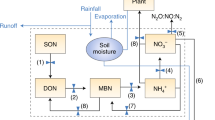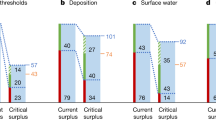Abstract
The current national commitments under the Paris Climate Agreement fall short of what is needed to stay below a 2 °C increase in global average temperature. One approach that has been proposed to close this ambition gap is the building blocks strategy, which aims to encourage initiatives focused on non-climate actions that can deliver a climate benefit. A key option under this framework is reducing global nitrogen pollution. Nitrogen pollution—driven largely by the inefficient use of synthetic fertilizer and manure—is one of the most important environmental issues of the twenty-first century, not least because of its climate impacts. Ambitiously mitigating nitrogen pollution could avoid greenhouse gas emissions equivalent to 5–10% of the remaining allowable emissions consistent with the 2 °C target. However, the climate benefits would be a minor component of the overall environmental benefits of reducing nitrogen pollution, which would come mainly from avoided water and air pollution. The fact that these benefits would accrue mostly at local scales is especially important for countries like the United States, marked by a shift toward “economic nationalism.” In these countries, the most politically viable climate actions will likely be ones that produce local benefits as great, if not greater, than those achieved internationally. This is also likely to be true in countries like China, where local nitrogen-related issues such as air and water pollution remain major national priorities. Nevertheless, there are several challenges that could stand in the way of improved nitrogen management being a successful building block: integrated nitrogen management solutions that reduce the risk of pollution swapping need to be developed, the policy challenges related to changing and monitoring farmer behavior need to be addressed, and nitrogen’s role as an essential agricultural input needs to be respected. A better understanding of these challenges could also help policy-makers develop viable climate mitigation strategies across the entire agricultural sector.
Similar content being viewed by others
References
Abalos D, Jeffery S, Sanz-Cobena A, Guardia G, Vallejo A (2014) Meta-analysis of the effect of urease and nitrification inhibitors on crop productivity and nitrogen use efficiency. Agric Ecosyst Environ 189:136–144
Abalos D, Jeffery S, Drury CF, Wagner-Riddle C (2016) Improving fertilizer management in the U.S. and Canada for N2O mitigation: understanding potential positive and negative side-effects on corn yields. Agric Ecosyst Environ 221:214–221
Aillery M, Gollehon N, Johansson R, Kaplan J, Key N, Ribaudo M (2005) Managing manure to improve air and water quality. USDA Economic Research Service Economic Research Report 9
Aunan K, Fang J, Vennemo H, Oye K, Seip HM (2004) Co-benefits of climate policy—lessons learned from a study in Shanxi, China. Energy Policy 32:567–581
Blanco G, Gerlagh R, Suh S, Barrett J, de Coninck HC, Diaz Morejon CF, Mathur R, Nakicenovic N, Ofosu Ahenkora A, Pan J, Pathak H, Rice J, Richels R, Smith SJ, Stern DI, Toth FL, Zhou P (2014) Drivers, trends and mitigation. In: Edenhofer O, Pichs-Madruga R, Sokona Y, Farahani E, Kadner S, Seyboth K, Adler A, Baum I, Brunner S, Eickemeier P, Kriemann B, Savolainen J, Schlömer S, von Stechow C, Zwickel T, Minx JC (eds) Climate change 2014: mitigation of climate change. Contribution of Working Group III to the Fifth Assessment Report of the Intergovernmental Panel on Climate Change. Cambridge University Press, Cambridge
Brink C, van Grinsven H (2011) Costs and benefits of nitrogen in the environment. In: Sutton MA, Howard CM, Erisman JW, Billen G, Bleeker A, Grennfelt P et al (eds) European nitrogen assessment. Cambridge Univ. Press, Cambridge
Business Standard (2015) Govt allows 100% production of neem-coated urea. January 7, 2015
Buzby JC, Wells HF, Bentley J (2013) ERS’s Food Loss Data Help Inform the Food Waste Discussion. Amber Waves, United States Department of Agriculture, Economic Research Service. Published June 3, 2013
Climate Action Tracker (CAT) (2016). Effect of current pledges and policies on global temperature. Available at http://climateactiontracker.org/global.html. Accessed 8 May 2017
Crutzen PJ, Mosier AR, Smith KA, Winiwarter W (2008) N2O release from agro-biofuel production negates global warming reduction by replacing fossil fuels Atmos. Chem Phys 8:389–395
Davidson EA, Kanter D (2014) Inventories and scenarios of nitrous oxide emissions. Environ Res Lett 9(10)
Dodds WK, Bouska WW, Eitzmann JL, Pilger TP, Pitts KL, Riley AJ, Schloesser JT, Thornbrugh DJ (2009) Eutrophication of U.S. freshwaters: analysis of potential economic damages. Environ Sci Technol 43(1):12–19
Eggleston S, Buendia L, Miwa K, Ngara T, Tanabe K (2006) IPCC Guidelines for National Greenhouse Gas Inventories. Intergovernmental Panel on Climate Change, Kanagawa, Japan
Erisman JW, Bleeker A, van Jaarsveld JA (1998) Evaluation of ammonia emission abatement on the basis of measurements and model calculations. Environ Pollut 102:269–274
Erisman JW, Sutton MA, Galloway JN, Klimont Z, Winiwarter W (2008) How a century of ammonia synthesis changed the world. Nat Geosci 1:636–639
Erisman JW, Galloway JN, Seitzinger S, Bleeker A, Butterbach-Bahl K (2011) Reactive nitrogen in the environment and its effect on climate change. Curr Opin Environ Sustain 3(5):281–290
Food and Agriculture Organization of the United Nations (2013) FAOSTAT. Rome, Italy
Galloway JN, Aber JD, Erisman JW, Seitzinger SP, Howarth RW, Cowling EB et al (2003) The nitrogen cascade. Bioscience 53:341–356
Government of India (2015) Neem Coated Urea. Budget Session. Lok Sahba, India
Gu BJ, Ge Y, Ren Y, Xu B, Luo WD, Jiang H, Gu BH, Chang J (2012) Atmospheric reactive nitrogen in China: sources, recent trends, and damage costs. Environmental Science & Technology 46:9420–9427
Harlan SL, Ruddell DM (2011) Climate change and health in cities: impacts of heat and air pollution and potential co-benefits from mitigation and adaptation. Curr Opin Environ Sustain 3:126–134
Hefting MM, Bobbink R, de Caluwe H (2003) Nitrous oxide emission and denitrification in chronically nitrate-loaded riparian buffer zones. J Environ Qual 32(4):1194–1203
Kanter D, Mauzerall DL, Ravishankara AR, Daniel JS, Portmann RW, Grabiel PM et al (2013) A post-Kyoto partner: considering the stratospheric ozone regime as a tool to manage nitrous oxide. P Natl Acad Sci USA 110:4451–4457
Kanter DR, Zhang X, Mauzerall DL (2015) Reducing nitrogen pollution while decreasing farmers’ costs and increasing fertilizer industry profits. J Environ Qual 44:325–335
Kanter DR, Wentz JA, Galloway JN, Moomaw WR, Winiwarter W (2017) Managing a forgotten greenhouse gas under existing U.S. law: an interdisciplinary analysis. Environ Sci Pol 67:44–51
Lelieveld J, Evans JS, Fnais M, Giannadaki D, Pozzer A (2015) The contribution of outdoor air pollution sources to premature mortality on a global scale. Nature 525:367–371
Li C, Frolking S, Butterbach-Bahl K (2005) Carbon sequestration in arable soils is likely to increase nitrous oxide emissions, offsetting reductions in climate radiative forcing. Clim Chang 72:321–338
Liu X, Zhang Y, Han W, Tang A Shen J, Cui Z, Vitousek P, Erisman JW, Goudling K, Christie P, Fangmeier A, Zhang F (2013) Enhanced nitrogen deposition over China. 494:459–462
Melillo JM et al (2009) Indirect emissions from biofuels: how important? Science 326:1397–1399
Narayanan, N. (2013). Massive nitrogen pollution accompanies China’s growth. Scientific American. Published on February 27, 2013
Nemet GF, Holloway T, Meier P (2010) Implications of incorporating air-quality co-benefits into climate change policymaking. Environ Res Lett 5
Ravishankara AR, Daniel JS, Portmann RW (2009) Nitrous oxide (N2O): the dominant ozone-depleting substance emitted in the 21st century. Science 326:123–125
Rogelj J, Schaeffer M, Friedlingstein P, Gillett NP, van Vuuren DP, Riahi K, Allen M, Knutti R (2016) Differences between carbon budget estimates unravelled. Nat Clim Chang 6:245–252
Schuur EAG, Bockheim J, Canadell JG, Euskirchen E, Field CB, Goryachkin SV, Hagemann S, Kuhry P, Lafleur PM, Lee H, Mazhitova G, Nelson FE, Rinke A, Romanovsky VE, Shiklomanov N, Tarnocai C, Venevsky S, Vogel JG, Zimov SA (2008) Vulnerability of permafrost to climate change: implications for the global carbon cycle. Bioscience 58(8):701–714
Sinha E, Michalak AM, Balaji V (2017) Eutrophication will increase during the 21st century as a result of precipitation changes. Science 357:405–408
Smith P, Bustamante M, Ahammad H, Clark H, Dong H, Elsiddig EA, Haberl H, Harper R, House J, Jafari M, Masera O, Mbow C, Ravindranath NH, Rice CW, Robledo Abad C, Romanovskaya A, Sperling F, Tubiello F (2014) Agriculture, forestry and other land use (AFOLU). In: Edenhofer O, Pichs-Madruga R, Sokona Y, Farahani E, Kadner S, Seyboth K, Adler A, Baum I, Brunner S, Eickemeier P, Kriemann B, Savolainen J, Schlömer S, von Stechow C, Zwickel T, Minx JC (eds) Climate change 2014: mitigation of climate change. Contribution of Working Group III to the Fifth Assessment Report of the Intergovernmental Panel on Climate Change. Cambridge University Press, Cambridge
Soussana, J.F., Saint-Macary, H., Chotte, J-L. (2015). Carbon sequestration in soils: the 4 per mil concept. Presentation to the “Agriculture and agricultural soils facing climate change and food security challenges: public policies and practices” workshop. September 16th, 2015. Paris, France
Steffen W, Richardson K, Rockstrom J, Cornell SE, Fetzer I, Bennett EM et al (2015) Planetary boundaries: guiding human development on a changing planet. Science 347:736
Stewart RB, Oppenheimer M, Rudyk B (2017) Building blocks: a strategy for near-tern action within the new global climate framework. Clim Chang. https://doi.org/10.1007/s10584-017-1932-1
Stubbs M (2010) Environmental Quality Incentives Program (EQIP): Status and Issues. Congressional Research Service. Washington D.C., USA
Sutton MAB, Howard CM, Bekunda M, Grizzetti B, de Vries W, van Grinsven HJM, Abrol YP, Adhya TK, Billen G, Davidson EA, Datta A, Diaz R, Erisman JW, Liu XJ, Oenema O, Palm C, Raghuram N, Reis S, Scholz RW, Sims T, Westhoek H, Zhang FS (2013) Our nutrient world: the challenge to produce more food and energy with less pollution. Centre for Ecology and Hydrology (Edinburgh) on behalf of the Global Partnership on Nutrient Management and the International Nitrogen Initiative
Sutton MA, Kanter DR, Howard C, Whalley P, Brownlie W (2016). Policy homes for nitrogen. INMS Project. GEF Full Size Project Document, Appendix 20
Trenkel ME (2010) Slow- and controlled-release and stabilized fertilizers: an option for enhancing nutrient use efficiency in agriculture. International Fertilizer Industry Association, Paris
UNEP (2013) Drawing down N2O to protect climate and the ozone layer: a UNEP synthesis report. United Nations Environment Programme Nairobi, Kenya
USDA (2015a) NRCS Conservation Programs: Environmental Quality Incentives Program (EQIP). http://www.nrcs.usda.gov/Internet/NRCS_RCA/reports/fb08_cp_eqip.html
USDA (2015b) NRCS Conservation Programs: Conservation Stewardship Program (CSP). http://www.nrcs.usda.gov/Internet/NRCS_RCA/reports/fb08_cp_cstp.html#contracts
USDA (2016) USDA Building Blocks for Climate Smart Agriculture and Forestry. USDA. Washington D.C. USA
USEPA (2008) Nitrogen backgrounder: challenges to nitrogen management. Washington D.C., USA
USEPA (2016) Technical Support Document: Technical Update of the Social Cost of Carbon for Regulatory Impact Analysis—Under Exective Order 12866. Interagency Working Group on Social Cost of Greenhouse Gases, United States Government
van Vuuren DP, Edmonds J, Kainuma M, Riahi K, Thomson A, Hibbard K et al (2011) The representative concentration pathways: an overview. Clim Chang 109(1–2):5–31
Velthof GL, Lesschen JP, Webb J, Pietrzak S, Miatkowski Z, Pinto M et al (2014) The impact of the nitrates directive on nitrogen emissions from agriculture in the EU-27 during 2000–2008. Sci Total Environ 468:1225–1233
Wellesley L, Happer C, Froggatt A (2015) Changing climate, changing diets. Chatham House Report. London, UK
Zaehle S, Ciais P, Friend AD, Prier V (2011) Carbon benefits of anthropogenic reactive nitrogen offset by nitrous oxide emissions. Nat Geosci 4:601–605
Zhang X, Davidson EA, Mauzerall DL, Searchinger TD, Dumas P, Shen Y (2015) Managing nitrogen for sustainable development. Nature 528:51–59
Zhu ZL, Chen DL (2002) Nitrogen fertilizer use in China—contributions to food production, impacts on the environment and best management strategies. Nutrient Cycling in Agroecosystems 63(2):117–127
Acknowledgements
I gratefully acknowledge the valuable comments provided by Michael Oppenheimer, Jessica Green, and Jonathan Hickman on earlier drafts of this paper, as well as comments from the participants in the SSRCdemocracy Working Group on Climate Change’s Workshop at Princeton University in November 2016. I would also like to thank three anonymous reviewers for their thoughtful and detailed comments.
Author information
Authors and Affiliations
Corresponding author
Rights and permissions
About this article
Cite this article
Kanter, D.R. Nitrogen pollution: a key building block for addressing climate change. Climatic Change 147, 11–21 (2018). https://doi.org/10.1007/s10584-017-2126-6
Received:
Accepted:
Published:
Issue Date:
DOI: https://doi.org/10.1007/s10584-017-2126-6




